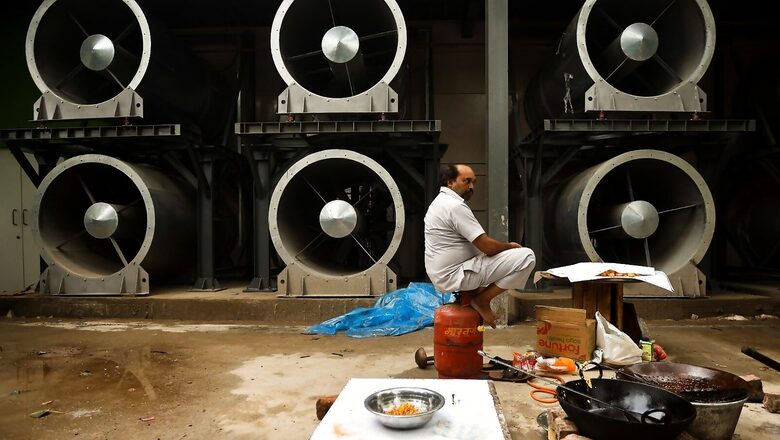
views
Delhi’s air quality turned “very poor” on Monday amid an increase in stubble burning, bursting of firecrackers and moderately unfavourable meteorological conditions which allowed accumulation of pollutants.
However, the 24-hour average air quality index (AQI) of 312 was still the second best for the Diwali day in seven years. Before this, the city recorded an AQI of 281 on Diwali in 2018. Delhi had recorded an AQI of 382 on Diwali last year, 414 in 2020; 337 in 2019; 319 in 2017; and 431 in 2016, according to the Central Pollution Control Board data.
प्रदूषण के क्षेत्र में दिल्लीवासी काफ़ी मेहनत कर रहे हैं। काफ़ी उत्साहजनक नतीजे आये हैं। पर अभी लंबा रास्ता तय करना है। दिल्ली को दुनिया का सबसे बेहतरीन शहर बनायेंगे https://t.co/VVoLxBrGd4— Arvind Kejriwal (@ArvindKejriwal) October 25, 2022
However, the fact that the air is relatively better does not imply that it is good air. At 4 pm on Monday, PM2.5 levels in the national capital’s 25 monitoring stations were five to six times higher than the national standard of 60 micrograms per cubic metre.
PM2.5 particles are fine particles with a diameter of 2.5 microns or less that can travel deep into the respiratory tract, reaching the lungs and entering the bloodstream. The city reported a 24-hour average AQI of 259 on Sunday evening, the lowest for the day before Diwali in seven years.
Pollution levels rose at night despite a drop in temperature and wind speed as people set off firecrackers in various parts of the national capital, and the number of farm fires increased to 1,318 this season, the most this season. However, low temperatures, calm winds, and nighttime firecracker emissions pushed air quality into the “very poor” or “severe” category by early Tuesday morning.
Air pollution management around Diwali has always been a mammoth task for Delhi-NCR authorities with increased emissions, unfavourable weather conditions, stubble burning in surrounding states, and more resulting in a thick blanket of smog enveloping the region throughout winters.
However, a number of measures have been taken by authorities in the past years to better the situation.
15-point Action Plan
Delhi CM Arvind Kejriwal had earlier announced a 15-point Winter Action Plan, stating that the plan will serve as a blueprint for the Delhi government to combat pollution this winter season. Kejriwal also urged neighbouring states to direct industries to switch to PNG and provide 24×7 power to the National Capital Region.
“The Delhi governments tireless efforts have started bearing fruit. PM10 levels in 2021-22 was down by 18.6% compared to 2017-18. We have reduced pollution by supplying electricity 24×7, shutting down thermal plants, inspecting construction sites regularly, getting industries to switch to PNG, increasing green cover, bringing a policy on electric vehicles, adding electric and CNG buses to our public transport fleet and developing smog towers. I am fully optimistic that we will win the fight against pollution with the cooperation of the people of Delhi,” Kejriwal had said.
Among the measures announced are:
• CUTTING DOWN STUBBLE BURNING
• CURBING DUST POLLUTION
• INSPECTION OF PETROL, DIESEL VEHICLES
• BAN ON GARBAGE BURNING
• INDUSTRIES SWITCH TO PNG
• BAN ON CRACKERS
• REAL-TIME STUDY ON POLLUTION
#WATCH | Delhi: Sprinkling of water being done in the area around Anand Vihar foot over bridge by Municipal Corporation of Delhi (MCD), as a measure against the rise in Air Quality Index (AQI) in the national capital pic.twitter.com/IzGb7Ae2JG— ANI (@ANI) October 25, 2022
GRAP – Graded Response Action Plan
The GRAP or the Graded Response Action Plan was first notified by the Ministry of Environment, Forests, and Climate Change in January 2017. Previously, it was the responsibility of the now-defunct Environment Pollution (Prevention and Control) Authority, but the GRAP began to be implemented by the CAQM beginning in 2021.
As suggested by its moniker, GRAP is a set of emergency measures that are activated stage-wise when air quality deteriorates. When Stage 1 of GRAP kicked in, Delhi’s AQI was in the poor category (211).
The AQI between 0 and 50 is considered ‘good,’ 51-100’satisfactory,’ 101-200’moderate,’ 201-300 ‘poor,’ 301-400’very poor,’ 401-450’severe,’ and 451-500 “severe+.” When the AQI falls further into the very poor, severe, and severe+ categories, the next three stages of GRAP are activated. Restricting construction activities and truck entry into Delhi are among the measures.
Ban on Firecrackers
The Delhi government has also identified firecrackers as a major source of air pollution during and after Diwali. In keeping with its efforts to improve Delhi’s air quality, the city government had this year reinstated a total ban on the manufacture, sale, and use of all types of firecrackers until January 1, including on Diwali, a practise it has followed for the past two years.
However, compliance is never complete, with the large number of high-decibel firecrackers burst throughout Diwali night as people in Delhi flouted the ban.
Smog Towers
According to a report by India Today, the Delhi government has claimed that Smog Towers are reducing air pollution by 70-80 percent up to 50 metres in advance of winter pollution. The Delhi government is also working to develop low-cost smog tower technology.
Smog Tower has a noticeable impact on pollution reduction up to 300 metres away, said the report. Last year, the city government began installing smog towers in Delhi in accordance with a Supreme Court order.
Stubble Burning
Stubble burning has been ascertained as one of the reasons behind the blanket of winter pollution over Delhi-NCR. Over the years, Delhi Chief Minister Arvind Kejriwal has requested that neighbouring states upgrade thermal power plants in NCR regions, and encouraged the use of CNG-powered vehicles and cleaner fuel.
He has also encouraged the Centre and states to offer free bio-decomposer spraying for crop residue management in-situ. As the Aam Aadmi Party took power in Punjab in the recent assembly elections, all eyes were on whether the party will curb farm fires this year.
However, politics over the issue continued, with Delhi Environment Minister Gopal Rai on Friday saying the Centre’s “blunt” refusal to provide cash incentives to Punjab farmers to avoid stubble burning “has impacted the entire campaign [against stubble burning] in the State”.
Speaking at a press conference here on Friday, Rai said the Punjab government had come up with a plan to provide financial assistance of ₹2,500 per acre to its farmers to dispose of crop residues without harming the environment. “The farmers had requested financial assistance. The State government then prepared a proposal stating that [the governments of Delhi and Punjab would each contribute 500, with the Centre contributing the remaining 1,500,” Rai had said, alleging that the Centre ‘refused’ the request.
Meanwhile, to discourage stubble burning in his Assembly district, Punjab Speaker Kultar Singh Sandhwan announced on Sunday that he will donate one lakh rupees to each village panchayat where farmers refrain from the practice.
According to an official statement issued here on Sunday, this amount will be paid from his discretionary quota. Sandhwan represents the Kotkapura Assembly constituency as an AAP MLA.
Read all the Latest India News here














Comments
0 comment